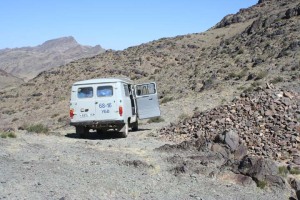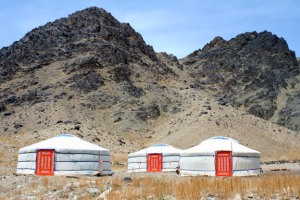First things first they say but I will not follow that rule today but rather tell the most recent news first.
We caught our first snow leopard today!
He is a 36 kg male, about three years old and his name is Aztai which means lucky in Mongolian. Can’t say that he was too lucky considering that he stepped in the trap but we were really lucky considering which trap he stepped in.
The particular trap is situated at the base of a cliff about 300 meters from camp on the other side of the valley; you can actually see the spot from our camp. I set it a few days ago after Tom had taken a walk and noticed that there were scrape marks there. We were figuring that the leopards would come down a ridge on our side of the valley (where there were also scrape marks), cross the valley, and head for the cliff. Since the valley is quite wide and open it was hard to figure out exactly which way the leopard would travel, especially since the snare is only about 20 cm in diameter and the leopard has to step in it. Anyway, I set the snare between two scrapes, just next to the cliff, hoping that the leopard would hug the cliff as he walked between the scrapes. Honestly, I didn’t like the trap a whole lot. The main reason for setting it was that it was a model that I hadn’t used before and I wanted to practice, we had some hours left in the afternoon, and it would at least have a better chance to catch a leopard if it’s set than if it’s lying in camp. I remember that when I came back I told Tom and Kim that we can pull it out in case we run out of traps cause it ain’t really good. Yesterday morning I attached a trap-transmitter to it that we had to modify a bit. It works fine but there is a rather great risk for false alarms. Yesterday afternoon my stomach started cramping and I got a bit sick, couldn’t even drink water so I headed for bed and stayed there. I woke up this morning hearing that Namshur, who had checked the transmitters from the mountain, had heard that one alarm was on. Apparently, it was the one across the valley. I felt quite weak and was trying to decide whether I could get up or not so to be honest, I was kind of hoping that it would be a false alarm. Pursee and Pujii, our two Mongolian biologists went over to check the trap and after a while I heard Tom shouting “they are running” and a little later “Irbis”, which is Mongolian for snow leopard. I crawled out of bed, mind set that I will try, but maybe let Tom or Chris run the capture in case I felt too weak. (Chris later told me that there was no chance that I was staying in bed and that he would have carried me to the trap if necessary).
Chris and I mixed the drugs, went over to take a look at the leopard, and loaded a dart. Chris then approached it and I walked around it to get a shot at the thigh. As the dart hit, we walked away to let the leopard fall asleep and as I looked up to the camp I realized that the entire staff was sitting outside the gers, drinking tea and watching us in binoculars. Maybe not the way I had pictured a snow leopard capture but it sure was a nice way.
Well the rest of the marking was more or less standard and everything went good. We gave Aztai the antidote and walked away a bit so he wouldn’t be stressed. As he got up and started moving around I decided that I will stop looking for snow leopards in the mountains. Even with binoculars it was almost impossible to see him. Snow leopards are truly magnificent animals and it was a stunning moment to be so close to one. At the same time, I felt bad for him, being stuck in the trap.
As we got back to camp, I sorted out the samples we had collected and then passed out in bed. This afternoon, Chris taught Kim and me how to suture in case any of the staff, or a leopard, gets injured. We used a hamster that was caught in a mouse trap in the office ger last night as a patient but despite our greatest efforts, we where not able to revive the poor fellow.
So, that’s what happened today, lets go back to the beginning.
We have had some very busy days, hiking and climbing to check for good trap sites and setting the last traps. At the moment, we have 17 traps armed and ready. Chris, the Austrian vet came two days ago and we have rehearsed capture procedures, drug dosages etc. I must say that I have learned so much from Tom, Chris and Kim the last week. I am really glad that Tom and Kim are here and it feels great to have them leading this project. Two days ago the alarm on a trap was released for the first time and we were all excited as we were sitting in the van, heading for the trap. Yesterday morning we had our second false alarm, both these times it seems as if a rodent have tripped the wire to the transmitter. Even though everyone was disappointed that there was no snow leopard in the traps, both occasions served as good rehearsals at the same time as they took the edge of the first “panic” when the alarm went.
I can’t think of what more to write, nothing seems important compared to the capture, though I have missed to write some things.
First I think that I have forgot to acknowledge that it is Guillaume Chapron who has designed this page and that it is he who shall have credit for it.
Second, it might be useful with a short presentation of the people working here so I will start from the beginning.
Tom McCarthy and Kim Berger are the two American scientists from Snow Leopard Trust, I think that I introduced in an earlier post (since I can’t read the blog myself, I might repeat stuff or leave important things out, my apologies for this).
The Mongolian staff consists of (we use short versions of their names cause the originals are quite long)
Pursee is a field biologist about my age. He works as a teacher in Ulaanbaatar when he is not here.
Pujii is a Master student working on occupancy estimates. She studies in Minnesota and will go back to U.S. in early September.
Namshur, our Mongolian vet and handyman. He has built a super-nice shower and some very impressive shoehorns of ibex horn
Biamba is our driver
Together with Koustubh, and Indian researcher, and Juan, a student from Argentina; Pursee and Pujii have fixed the camp this summer and conducted the camera and site occupancy studies.
Our Mongolian family consists of:
Midget, who is the caretaker
Oyuna, who is the cook
Benji, their daughter who will leave for school in Dalandzadgad in a little while.
Last person is Chris Waltzer, an Austrian vet, who arrived here a couple of days ago. Chris works in Austria, with cheetah in Iran and with wild ass, wild camels and Przewalskis horse in Mongolia. He is a very competent and calm vet and I have learned a lot from him the last days.
Tom and Chris just came back from the mountain-transmitter-check and no alarms are on tonight.











